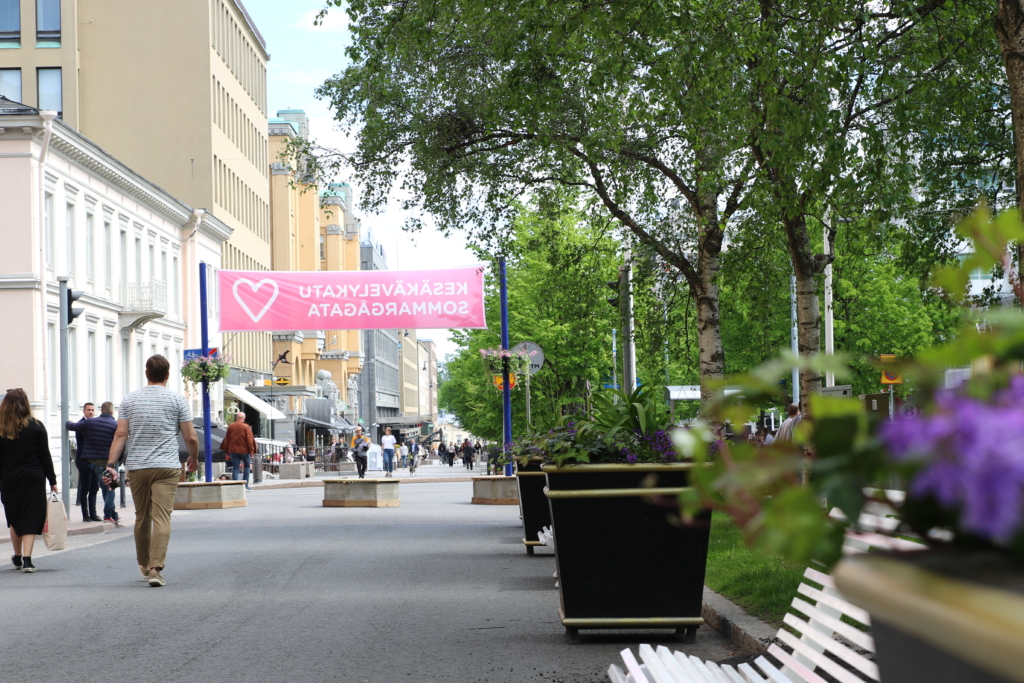
Article categories: Archive News
Vaasa city centre’s vitality on the rise
Published: 24.5.2024
The vitality of Vaasa’s city centre is on the rise, according to the annual survey conducted by Elävät Kaupunkikeskustat ry. Notably, the number of vacant commercial spaces has decreased, and the number of businesses open on weekdays has increased compared to last year. In the comparison of city centres, Vaasa ranked sixth out of 34 cities this year.
The vitality of city centres has been monitored since 2015 using a method developed by Elävät Kaupunkikeskustat (EKK) ry. This year’s survey included 34 cities.
A straightforward way to track the development of vitality is by monitoring changes in the number of vacant commercial spaces. In Vaasa, the proportion of these spaces increased until spring 2023, but has since declined, reaching its lowest level in four years.
– We have a high number of commercial spaces relative to the population, and the reduction in vacant spaces indicates confidence in the city centre’s vitality. It’s also important to note that the count was done before the opening of the Sokos department store and H&M’s announcement of a new store, which will further improve the situation, says Markku Järvelä, Director of Urban Environment.
Vaasa also fares well in the national comparison, ranking sixth out of 34 cities this year. The overall vitality score for the city centre is 3.045, up from 2.809 last year. Vacant commercial spaces now account for 10.28% of all commercial spaces, down from 12.50% the previous year. Both figures are better than the national average.
– The vitality score has generally declined in cities, mainly due to the decrease in the number of shops. Despite the challenging overall trend, we in Vaasa are moving in a very positive direction, Järvelä notes.
Visit Vaasa CEO Max Jansson is also optimistic about the future.
– For example, hotel stays increased by six percent compared to the previous year. Most customers were Finnish, but nearly 19% now come from other countries. The feedback has been excellent, particularly praising the service level and the wide range of restaurants and shops. We have a close and well-functioning cooperation with entrepreneurs and the city, which is crucial to staying competitive, Jansson says.
Impact of implemented measures
Vaasa’s city centre has been actively developed in recent years, with new jobs and services particularly in the pedestrian area.
General activity appears to have increased, including traffic volumes. Public transport usage is up, there is more walking and cycling, and the number of parking events has increased. The Pulse of the Pedestrian Street project last year also shows that the pedestrian area is Vaasa’s most attractive.
– We have invested in the market square’s play and exercise area, expanded the pedestrian area, created a summer pedestrian street, improved traffic arrangements, and updated lighting and traffic light controls. I believe these measures have impacted the number of services and jobs in the city centre, as well as its overall vitality, says Jukka Talvi, Director of Municipal Engineering.
– We also aim to find out why some easily accessible commercial spaces by car remain vacant and whether we can improve the street’s attractiveness to encourage more people to stop by these shops. We also plan to involve residents and local businesses in the planning of development measures, Talvi continues.
Measuring vitality with multiple indicators
Vitality scores are based on an open method developed by EKK, where city centres are evaluated using five key vitality variables:
- The proportion of shops and restaurants out of all commercial spaces in the city centre
- The proportion of vacant commercial spaces
- Commercial density (the proportion of commercial spaces relative to the city centre’s area)
- The city centre’s vitality score (the total number of shops and restaurants minus vacant commercial spaces, relative to the city’s population)
- Population density in the fifteen-minute city centre (population per square kilometre within a 1 km radius of the commercial centre)
Scores were assigned in five different areas, with the best national performance receiving 35 points and the weakest receiving one point. The total score was composed of the sums of these five areas.
Explore the study: Suomalaisten kaupunkikeskustojen elinvoima keväällä 2024 (pdf)
Read the Elävät Kaupunkikeskustat ry’s press release in finnish.
